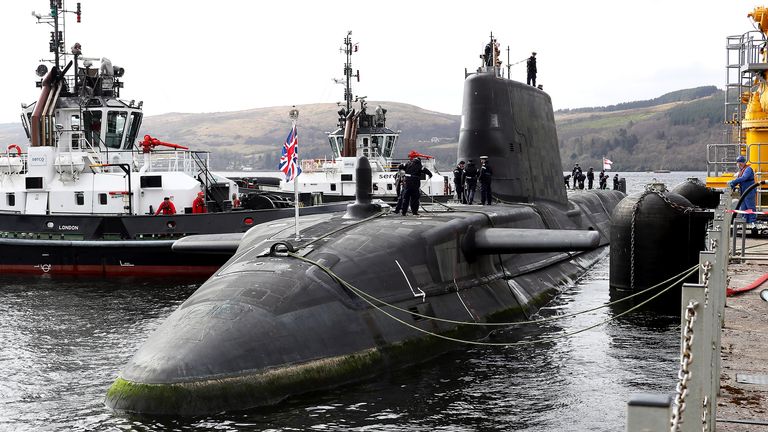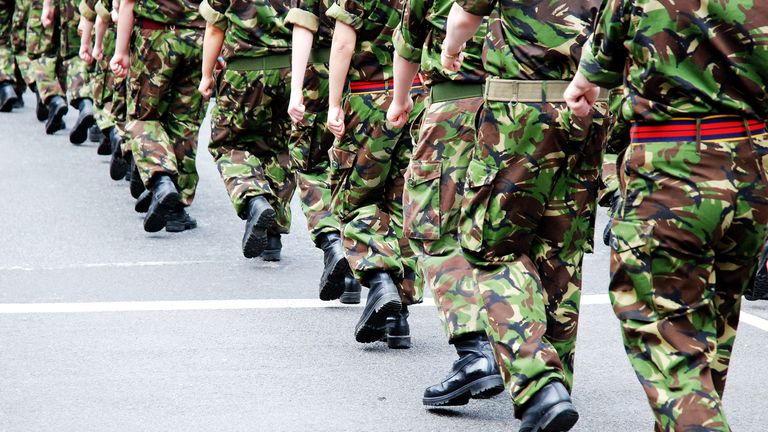UK has no ‘credible’ plan to fund military equipment as multibillion-pound deficit revealed, report | UK News
The UK has no “credible” plan to buy all the weapons it needs after a huge jump in the cost of the nuclear deterrent helped to create a record funding gap, a group of MPs has warned.
Inflation and a weak pound also contributed to the hole of at least £16.9bn in a rolling, 10-year plan to procure equipment for the Army, Royal Navy and Royal Air Force, the Public Accounts Committee said in a scathing report.
The actual deficit is likely to be closer to £30bn if all the capabilities required by the Army – rather than only those it can afford – are included in the costs, the MPs said on Friday.
The committee accused the Ministry of Defence (MoD) of putting off painful decisions about what equipment programmes would have to be cancelled for the plan to be affordable.
Instead, defence chiefs were found to have been basing their sums around the optimistic belief that the government would boost defence spending to 2.5% of national income from around 2.1% – even though there is no guarantee when this will happen.
The findings came after MPs and military experts expressed dismay at a failure by the Treasury to increase defence spending in the Spring Budget despite mounting security threats and at a time when friends and foes are ramping up their own military investments.
Dame Meg Hillier, the chair of the Public Accounts Committee, said: “In an increasingly volatile world, the Ministry of Defence’s lack of a credible plan to deliver fully funded military capability as desired by government leaves us in an alarming place.”
She said this was not a new problem, with defence procurement characterised by ballooning costs and delays.
‘Clear deterioration in affordability’
“We’re disappointed that not only are the same problems we’re used to seeing on display here, but they also appear to be getting worse,” Dame Hillier said.
“Despite a budget increase, this year’s plan shows a clear deterioration in affordability. The MoD must get a better grip, or it won’t be able to deliver the military capabilities our country needs.”
The committee said the £16.9bn gap in affordability was the largest since the MoD started publishing its rolling 10-year equipment plan in 2012.
It came despite the government increasing planned spending on military equipment over the ten years to 2033 – the period that the MPs were examining – by £46.3bn to £288.6bn from 12 months earlier.
However, any hope of balancing the books was then sunk by a £38.2bn rise in funding over the same period for the Defence Nuclear Organisation – which is charged with renewing a fleet of nuclear-armed submarines and the missiles and warheads it carries.
The MPs voiced concern the spiralling costs for what is the UK’s top defence priority could further squeeze the budget for its conventional military capabilities.
Adding to the pressure, the MoD said inflation would push up costs for the equipment programme by £10.9bn over the decade, while unfavourable foreign exchange rates – such as when buying equipment from US companies when the pound is weak against the dollar – would add a further £2.2bn.
“The MoD, however, is unwilling to address this deficit by making major decisions about cancelling programmes,” the report said.
“It asserts that such decisions should wait until after the next Spending Review, which is expected in 2024 but might conceivably be delayed by the forthcoming general election, the timing of which is also uncertain.”
Read more:
UK to supply 10,000 more drones to Ukraine
Rolls-Royce to create hundreds of nuclear submarine jobs in Scotland and Wales
Shortfalls across the board
There was also a shortage of skilled officials to oversee the delivery of complex procurement programmes – the equipment plan covers some 1,800 different projects to buy everything from communications gear to warships.
In a sign of strain, only two out of 46 projects included in the Government Major Projects Portfolio – so the most important equipment programmes – are ranked as being highly likely to be delivered to time, budget and quality.
By contrast the successful delivery of five other big projects – including new communications technology, nuclear submarine reactors and missiles – are rated as unachievable.
Asked about the findings of the report, a Ministry of Defence spokesperson said: “Our Armed Forces stand ready to protect the UK and as a leading contributor to NATO, we continue to defend our national interests and those of our allies.
“We are delivering the capabilities our forces need – significantly increasing spending on defence equipment to £288.6 billion over the next decade, introducing a new procurement model to improve acquisition, and confirming our aspiration to spend 2.5% GDP on defence.
“By maintaining part of our equipment plan as uncommitted spend, we have the flexibility to better adapt to changing technology and emerging threats.”

